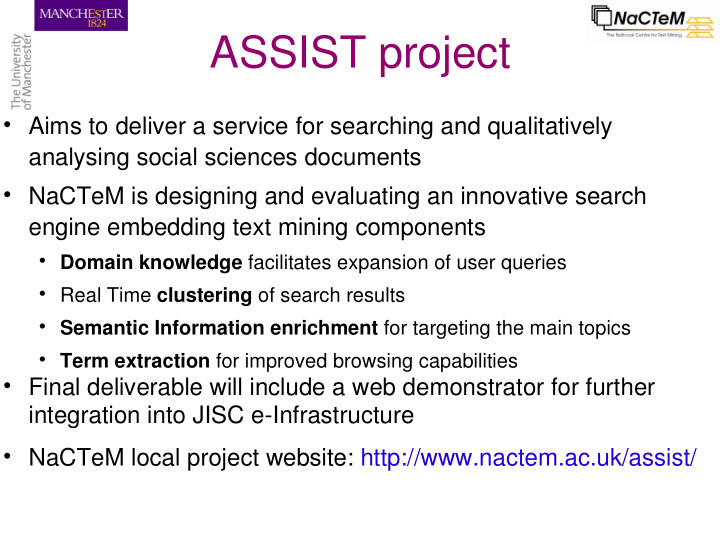



ASSIST project • Aims to deliver a service for searching and qualitatively analysing social sciences documents • NaCTeM is designing and evaluating an innovative search engine embedding text mining components Domain knowledge facilitates expansion of user queries Real Time clustering of search results Semantic Information enrichment for targeting the main topics Term extraction for improved browsing capabilities • Final deliverable will include a web demonstrator for further integration into JISC e-Infrastructure • NaCTeM local project website: http://www.nactem.ac.uk/assist/
ASSIST project • Limitation of existing search engines return long list of documents accessed through laconic contexts of the words queried as plain-text • ASSIST search engine improves: the research process with domain knowledge for the Educational Evidence Portal (EPPI-Centre) the content access of documents through semantic information for sociological analysis of mass-media documents (NCeSS)
Technical Characteristics TM components Extraction Search Engine •Named Entity Recognizer: BaLIE •Content Lucene •Term Extractor: Termine •Metadata • Sentiment Analyzer: HYSEAS Indexed Search result clustering Web Query Interface Lingo Documents Lexis Nexis NewsPaper User DataBase Query Named Entities Terms Sentiment Analysis
Query interface Expanding the standard query interface Semantic operators to build complex queries Browsing documents through a domain taxonomy
Search Result Interface Clustering the query results in real time Lingo algorithm merges instances of commonly occurring phrases, keeping the best candidate to describe each cluster A familiar presentation of query results including snippets
Search Result Interface Document content is described using semantic information makes document analysis easier, faster and more efficient
Access to document contents Document content is described using semantic information Metadata: informing the origin of documents Terms: most significant multi-words phrases in the document Named Entities: main discourse objects belonging to predefined categories
Document Analysis Identification of conceptually similar documents using the most commonly occurring terms and words in the source document Highlighting selected semantic information within the document Selecting terms according to their importance and using them to browse documents
Document Analysis Named Entities are selected and displayed according to their categories 26 categories of Named Entities are recognized and coloured in their context
Sentiment Analysis Subjective Sentiment Automatic estimation of the opinion of the writer regarding a fact or an event Negative opinion Neutral opinion Positive opinion
Future Work • Automatic Summarization for accessing cluster content Extraction of the most salient sentences from the documents in a cluster • Improving the interaction between the system and the users Correction of the title and the content of the clusters Graphical interfaces to add user defined annotations
Recommend
More recommend